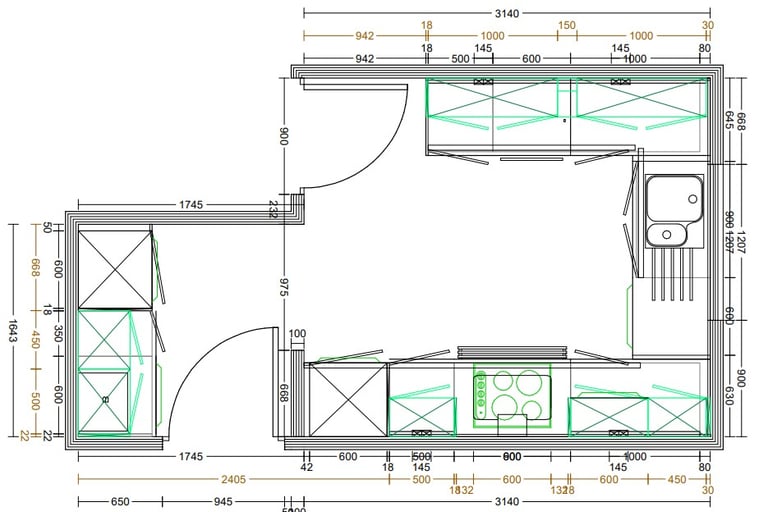The kitchen is often considered the heart of the home, a space where culinary creativity meets social interaction. Designing a kitchen that’s both functional and stylish requires careful planning, particularly in UK homes where space and layout can vary greatly. Here’s a comprehensive guide to help you craft the perfect kitchen, whether you're working with a compact city flat or a spacious countryside home.
1. Assess Your Needs and Lifestyle
Before diving into design specifics, think about how you use your kitchen. Are you an avid cook who needs ample workspace, or is your kitchen more of a social hub for family and friends? Make a list of must-haves and nice-to-haves, such as a large island, extra storage, or high-tech appliances.
2. Consider Your Layout
The layout is the backbone of kitchen design. Popular configurations include:
Galley Kitchens: Ideal for narrow spaces, with two parallel countertops.
L-Shaped Kitchens: Great for open-plan homes, providing flexibility and flow.
U-Shaped Kitchens: Offers plenty of storage and workspace.
Island Kitchens: Perfect for larger spaces, adding functionality and a social focal point.
Apply the "kitchen work triangle" principle, ensuring efficient movement between the sink, cooker, and refrigerator.
3. Maximise Space and Storage
UK kitchens often face space constraints, making smart storage solutions essential:
Use corner units with pull-out shelves.
Opt for integrated appliances to save space.
Install tall cabinets to utilise vertical space.
Incorporate drawer dividers and organisers for utensils and spices.
4. Choose Quality Materials
Materials set the tone for your kitchen and should balance style with durability. For countertops, consider:
Quartz: Low-maintenance and hardwearing.
Granite: Elegant and heat-resistant.
Laminate: Affordable and versatile.
For cabinetry, painted wood is a timeless choice that suits both modern and traditional designs.
5. Pick the Right Colour Scheme
Colour plays a significant role in creating the desired atmosphere. Neutral tones like white, grey, and beige are popular for their timeless appeal. Alternatively, consider bold accents like navy blue or forest green for a modern twist. Ensure your palette complements the rest of your home’s decor.
6. Focus on Lighting
A well-lit kitchen is both functional and inviting. Combine task lighting (e.g., under-cabinet lights) with ambient lighting (e.g., pendant lights over an island). Natural light is also a bonus, so maximise windows and skylights where possible.
7. Plan for Energy Efficiency
Energy efficiency is an essential consideration in modern kitchen design. Choose appliances with high energy ratings and incorporate LED lighting to reduce electricity consumption. Insulating materials and double-glazed windows can help maintain temperature control.
8. Personalise with Finishing Touches
Make your kitchen uniquely yours by adding personal touches. Display family photos, hang artwork, or incorporate open shelving to showcase cookbooks and decorative items. Plants can also bring life and freshness to the space.
9. Consult Professionals
While DIY design is tempting, enlisting the help of kitchen designers or fitters can ensure a smoother process. Professionals can offer insights into space optimisation, building regulations, and material selection.
10. Set a Realistic Budget
Finally, establish a budget that aligns with your vision. Allocate funds wisely, prioritising elements like appliances and cabinetry while finding cost-effective options for decor and accessories.
Conclusion
Designing a kitchen in the UK requires a blend of creativity, practicality, and attention to detail. By assessing your needs, optimising your layout, and incorporating quality materials and finishes, you can create a kitchen that’s both beautiful and functional. Whether you’re renovating or building from scratch, this guide can help you bring your dream kitchen to life.
Designing the Perfect Kitchen: A Guide for UK Homeowners


Quality Kitchens & Bedrooms
Local independent supplier of kitchens and bedrooms covering North Lancashire and South Cumbria.
contact us
© 2024. All rights reserved.
Carman Hill Kitchens and Bedroom Limited is registered with Companies House at Brunel House, 9 Penrod Way, First Floor, Morecambe, Lancashire, England, LA3 2UZ. Companies House number 16004582
